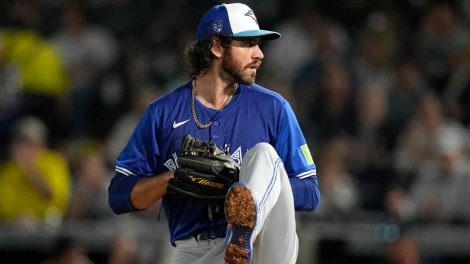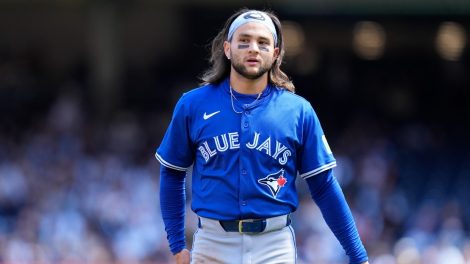TORONTO – It’s easy to say that April stats don’t mean all that much until you’ve watched a team plummet to the bottom of the standings in the span of a month. At that point, the results matter a whole lot.
Through some combination of injuries, poor performances and small sample randomness, the Blue Jays, Giants and Mets all begin May last in their respective divisions. Reaching the playoffs now looks much harder for these teams, each of which earned a wild-card berth in 2016.
So what happens next? Surely these teams must respond to their struggles in some noticeable way, right? Well, not necessarily.
Take the Blue Jays as an example. Unless they have an extended hot streak or two in their future, their front office will have to contemplate the possibility of selling off pieces later this summer.
Maybe that’s what ends up happening, but for the next couple of months, there’s little to be gained by publicly declaring that a sell-off is coming. It’d alienate fans, first of all. It’d also be an especially discouraging message to send to the players who worked all off-season for the chance to compete.
[snippet id=3319157]
Plus, if history offers any indication, other teams just aren’t looking to buy right now. It’s extremely rare to see noteworthy trades before the end of June, let alone in May (one example does come to mind: when the Pirates sent Nate McLouth to the Braves on June 3, 2009, Pittsburgh’s fans and players criticized the move openly). In the meantime, rival teams can monitor the Blue Jays for potential reinforcements so they’re prepared to pursue players should they become available.
If the Blue Jays are still nine games below .500 in two months’ time, the standings will dictate their next steps: it’ll be time to sell selectively and build for 2018 and beyond. But it’s hard to see how making the decision to sell would benefit them now considering FanGraphs still gives them a 14 per cent chance of reaching the playoffs and teams rarely enter ‘buy’ mode this early.
For struggling teams like the Blue Jays, Giants and Mets, there’s nothing to be gained from rushing deals. More likely, they let the season play out a while longer, hopeful that their struggles end soon and prepared to change course if not.
Around baseball, some other noteworthy trends have emerged after one month of baseball…
THAMES HITTING LIKE A STAR
This time 12 years ago, Chris Shelton looked like a star in the making. In 25 games for the Detroit Tigers, the first baseman hit 10 home runs while batting .326/.404/.783. The breakout wasn’t sustainable, though, and Shelton would hit just eight more home runs in his MLB career.
Because of Shelton and countless others, we’re cautious when someone like Eric Thames comes along and hits .345/.466/.810 with 11 home runs. Some regression is inevitable.
At the same time, Thames has been controlling the strike zone with a much-improved plate approach. While Shelton had 27 strikeouts against nine walks in 2005, Thames has 18 walks compared to 23 strikeouts. Plus, he’s chasing pitches outside the strike zone half about as often as he did in his first stint at the MLB level. So while the power may drop off, Thames’ plate approach is no fluke.

SWEET RELIEF
A reliever enters the game, and you check his numbers: 8.9 strikeouts and 3.6 walks per nine innings with a .239 opponents’ average. His fastball clocks in at 93 or 94 mph and he generates a swing and miss every ten pitches or so.
How would you describe him? Late-inning material? Potential closer? Few fans would look at those numbers and think ‘nothing special here,’ and yet those numbers are the league averages for MLB relievers this year—as unremarkable as it gets, in other words.
When a reliever’s on the mound, 23.0 per cent of batters strike out. By way of comparison, all-time strikeout leader Reggie Jackson whiffed 22.7 per cent of the time.
It’s not just relievers, either. Strikeouts are up across the board, with a league-wide strikeout rate of 21.6 per cent. It’s an all-time high, and based on the way things are trending, it’ll only go up from here. Build your bullpens accordingly.
[relatedlinks]
QUIETLY POWERFUL
There’s been no shortage of attention surrounding Thames, but three other players reached double-digits in home runs with far less fanfare.
Khris Davis of the Athletics hit 10 home runs, and now has more homers than anyone in the last calendar year, with 49. Ryan Zimmerman, still just 32 years old even though it seems like he’s been around forever, has 11 home runs for a high-powered Nationals lineup that’s averaging close to seven runs per game. Lastly, Yankees rookie Aaron Judge did a convincing Giancarlo Stanton impression on his way to 10 home runs and at least as many Statcast records.

BEST OF THE BEST
Mike Trout and Bryce Harper didn’t quite reach double-digits in home runs, but they’re off to incredible starts, even by their lofty standards. Trout hit .364/.443/.707 with seven home runs in April while Harper hit .391/.509/.772 with nine homers. We’ve come to expect that kind of excellence from Trout, but Harper appears poised to bounce back from a good-but-not-great 2016 season in which he may or may not have been injured.









